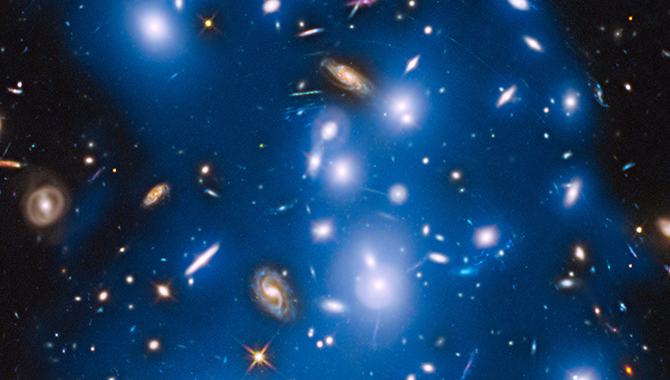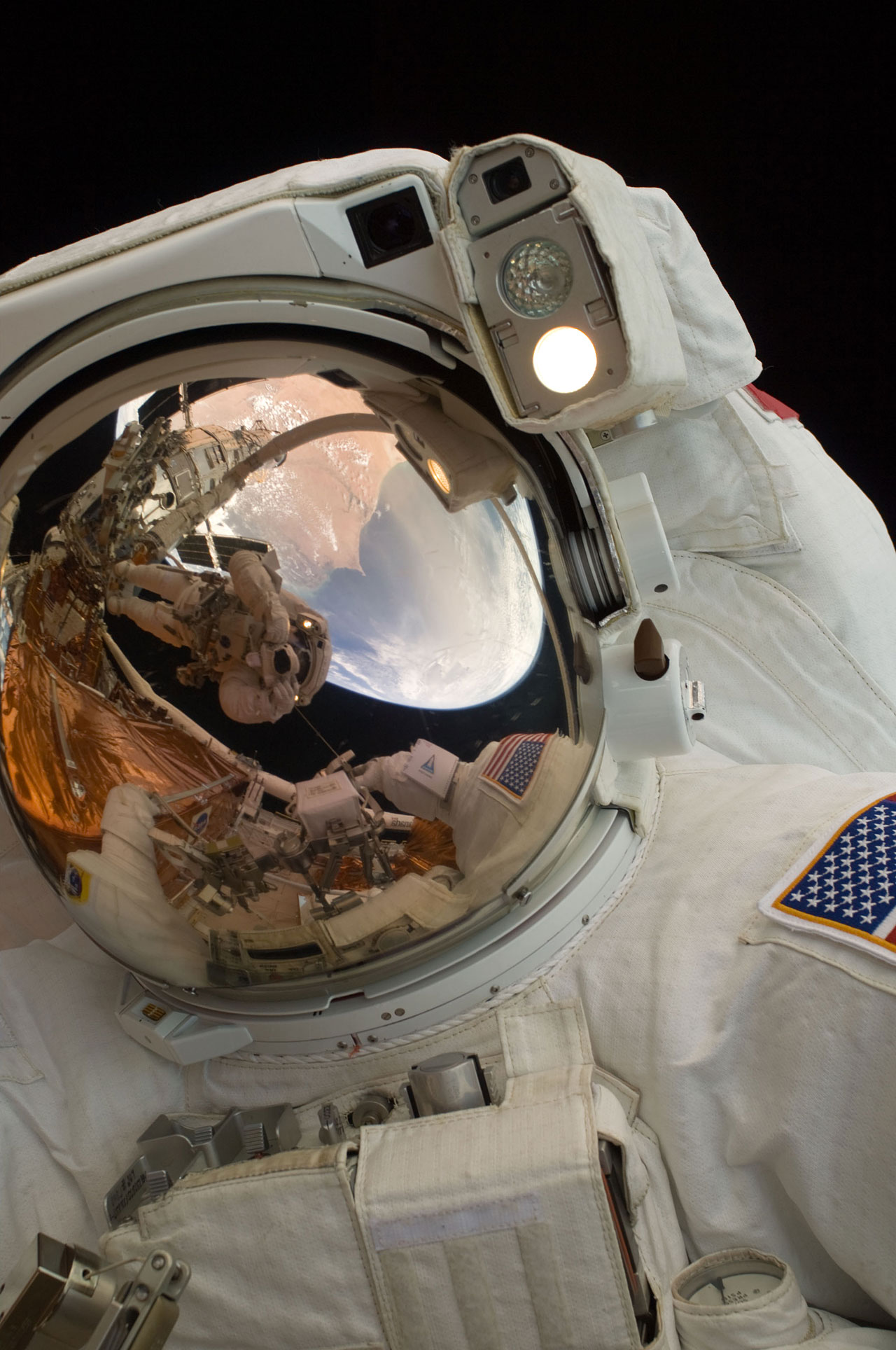
The ghostly glow of stars from galaxies torn apart billions of years ago as observed recently by the Hubble Space Telescope.
Photo Credit: NASA/ESA/IAC/HFF Team, STScI
View full size image here.
On December 2, 1993, the Endeavour shuttle crew set out on the most complex space shuttle mission ever: to rescue the Hubble Space Telescope.
The Hubble Space Telescope was conceived to do the impossible: provide an unobstructed view of the universe. Before Hubble, ground-based telescopes—dating as far back as the 17th century—had helped astronomers investigate the cosmos. But these tools had one enormous drawback: Earth’s atmosphere. The atmosphere is critical for human survival. Without it, people would be exposed to sources of radiation such as gamma rays, ultraviolet (UV) rays, and x-rays. But this protection comes at a cost to scientific discovery as the atmosphere distorts our view of objects in space. From its unique vantage point in space, Hubble was expected to provide ten times greater resolution than any ground-based telescope ever could.
Unfortunately, Hubble didn’t perform as planned. Launched on the shuttle Discovery in 1990, a serious problem became apparent almost immediately: images sent back from Hubble were blurry. The telescope intended to transcend ground-based observations was not doing its job.
Scientists determined that the issue involved Hubble’s primary mirror. The telescope works by capturing more light than the unaided human eye can perceive through its large—2.4 meters in diameter—main mirror. That light bounces off a secondary mirror, where it is reflected toward the spacecraft’s science instruments. At launch, Hubble housed five instruments: the Wide Field/Planetary Camera (WFPC), the Goddard High Resolution Spectrograph (GHRS), the Faint Object Camera (FOC), the Faint Object Spectrograph (FOS), and the High Speed Photometer (HSP).
Each instrument was designed to examine the light from Hubble’s main mirror in a different way. The WFPC, which was as big as a piano, consisted of a multi-sensor panoramic capability and a high-resolution camera, which together delivered images of bright objects in space. The FOS was a spectrograph: an instrument that parses light to determine the properties of celestial objects. It concentrated on faint objects across a wide spectral range. The GHRS also looked at the components of objects in space but focused solely on the UV spectrum, examining objects in fine detail. The FOC was contributed by the European Space Agency. Its detectors were extremely sensitive, which allowed the instrument to function essentially as a telephoto lens, providing high-resolution images of distant objects. The HSP concentrated on the near-UV to the visible light spectrum. The ability of these instruments to send clear images back to Earth all depended on the main mirror focusing the light perfectly.
But that mirror was defective. It contained a spherical aberration: a flaw arising from a manufacturing malfunction that rendered the mirror too flat. The error was slight: 1/50 the thickness of a human hair. But that was enough. Light reflected off the wrong area of the mirror, diffusing its focus. As a result, Hubble’s instruments didn’t get the light they needed to provide pristine images of objects in space.
The main mirror could not be replaced. So scientists decided to correct the problem at a different level: within and around the scientific instruments. Essentially, they needed to fix the telescope with a sophisticated pair of spectacles that would enable it to see clearly.
Scientists decided to replace the existing WFPC with an updated version, WFPC2, which contained built-in corrective optics. This version featured a series of mirrors that reversed the spherical aberration in the main mirror, allowing the cameras in WFPC2 to capture images correctly. But the three remaining instruments could not be replaced as readily. Instead, a Corrective Optics Space Telescope Axial Replacement (COSTAR) was installed on the spacecraft. COSTAR was not an instrument itself but rather a means of correcting the path of light as it was transmitted from the main mirror to the three scientific instruments. It consisted of 5,300 parts, including ten curved mirrors that delivered the correct light to the instruments’ apertures. To make room for COSTAR, the HSP—the least-used of Hubble’s instruments—had to be removed.
But determining the solutions to Hubble’s vision problem was not the same as implementing them. The spacecraft could not be returned to Earth; the repairs would have to be conducted in space. Fortunately, Hubble was designed to facilitate on-orbit servicing. But it had never been done before. Furthermore, the required repairs went beyond replacing the WFPC, adding COSTAR, and removing the HRS. Other aspects of the telescope, such as some of the gyroscopes used to ensure the spacecraft pointed in the correct direction, were performing suboptimally as well. Hubble needed a comprehensive overhaul, and astronauts aboard a space shuttle would have to do it.
The team of astronauts tasked to fix Hubble trained for nearly a year to master the tools and skills they would need to conduct multiple consecutive spacewalks, or extravehicular activities (EVAs), and to make the necessary repairs. On December 2, the Space Shuttle Endeavour (STS-61) lifted off from Cape Canaveral with a crew of seven: Thomas Akers, Kenneth Bowersox, Richard Covey, Jeffrey Hoffman, Story Musgrave, Claude Nicollier, and Kathryn Thornton. Their goal was to restore the telescope’s sight and showcase its unique on-orbit servicing capability. Ultimately, it took the astronauts a record-setting five EVAs to complete the repairs. The first EVA lasted seven hours and fifty minutes, the second-longest spacewalk to date. The total time spent outside the shuttle to complete the Hubble repairs was 35 hours and 28 minutes.
The Endeavour returned to Kennedy Space Center on December 13. A month later, on January 13, 1994, the first images from the rehabilitated telescope were released by NASA. The resolution was perfect.
Hubble has gone on to facilitate insight into some of the greatest mysteries of the universe. Using information from its images, scientists were able to identify the age of the universe and determine its expansion rate. Hubble helped reveal the existence of dark energy, while its deep field capacity enabled observations into the farthest regions of the universe. Hubble pinpointed the world’s oldest planet, estimated at 13 billion years old. Currently, because some of its instruments can determine the components of celestial objects, Hubble is helping scientists search for planets beyond our solar system that exhibit the potential for life.
Learn more about the Hubble Space Telescope.
Watch a film featuring highlights of STS-61 and the repairs to Hubble.









